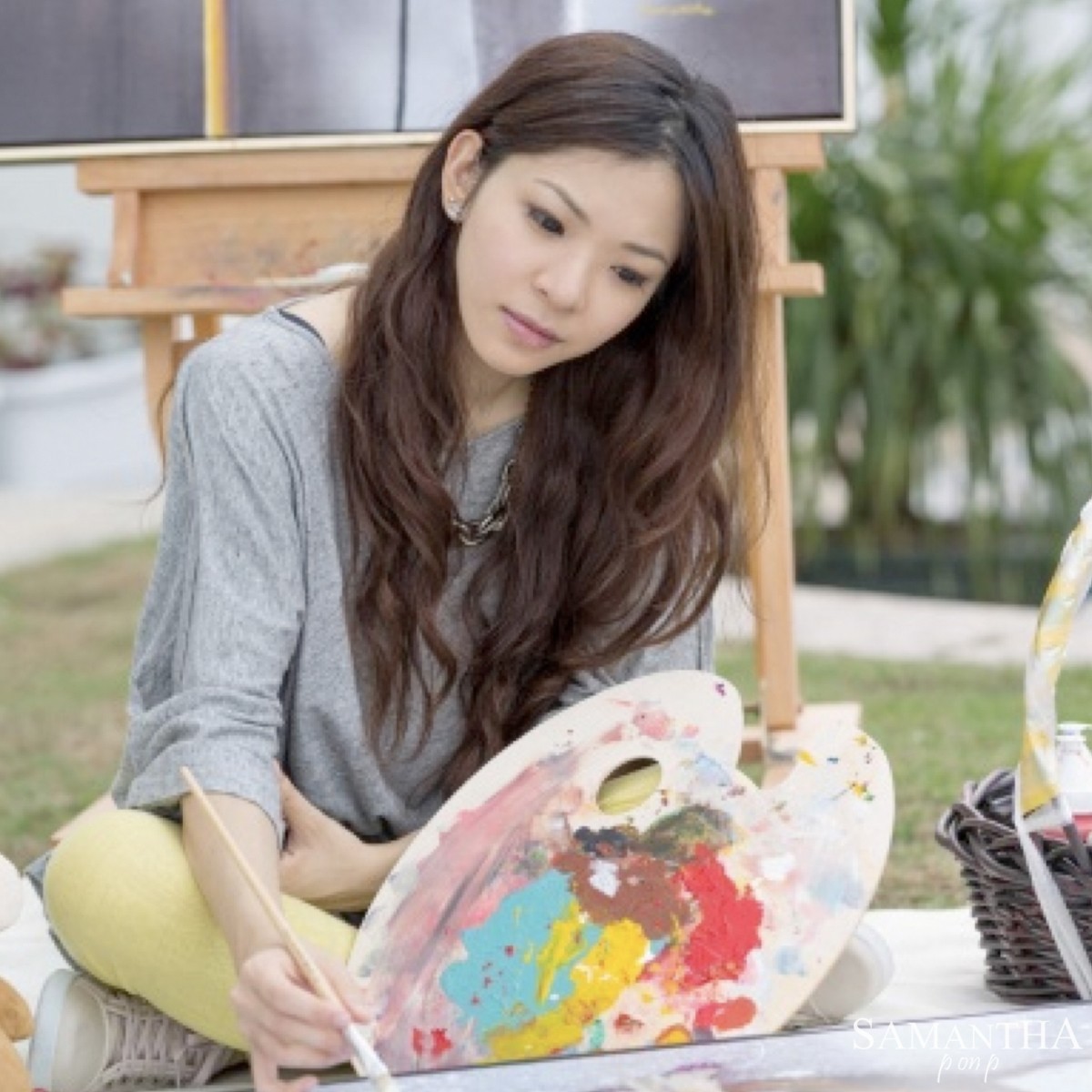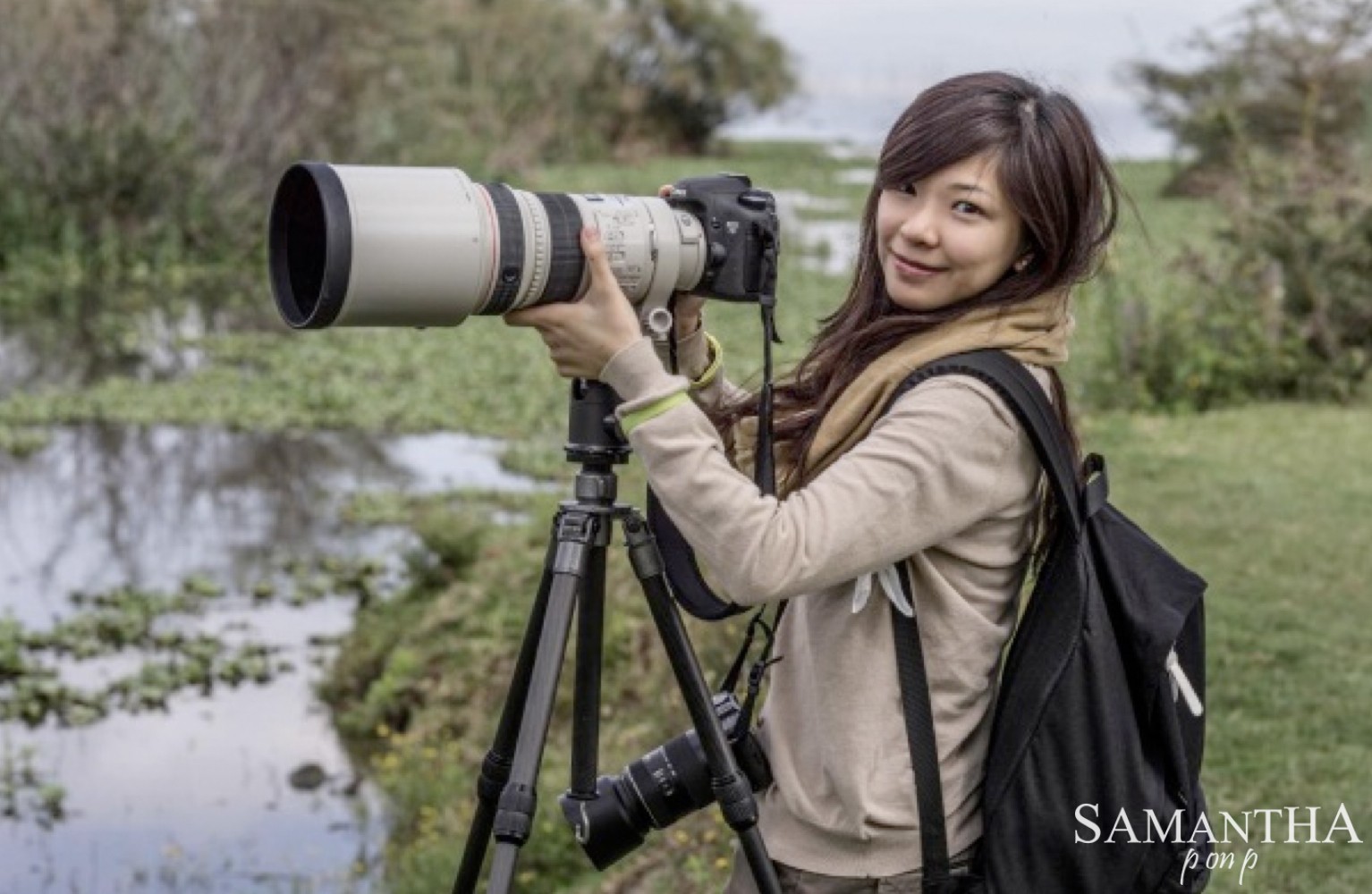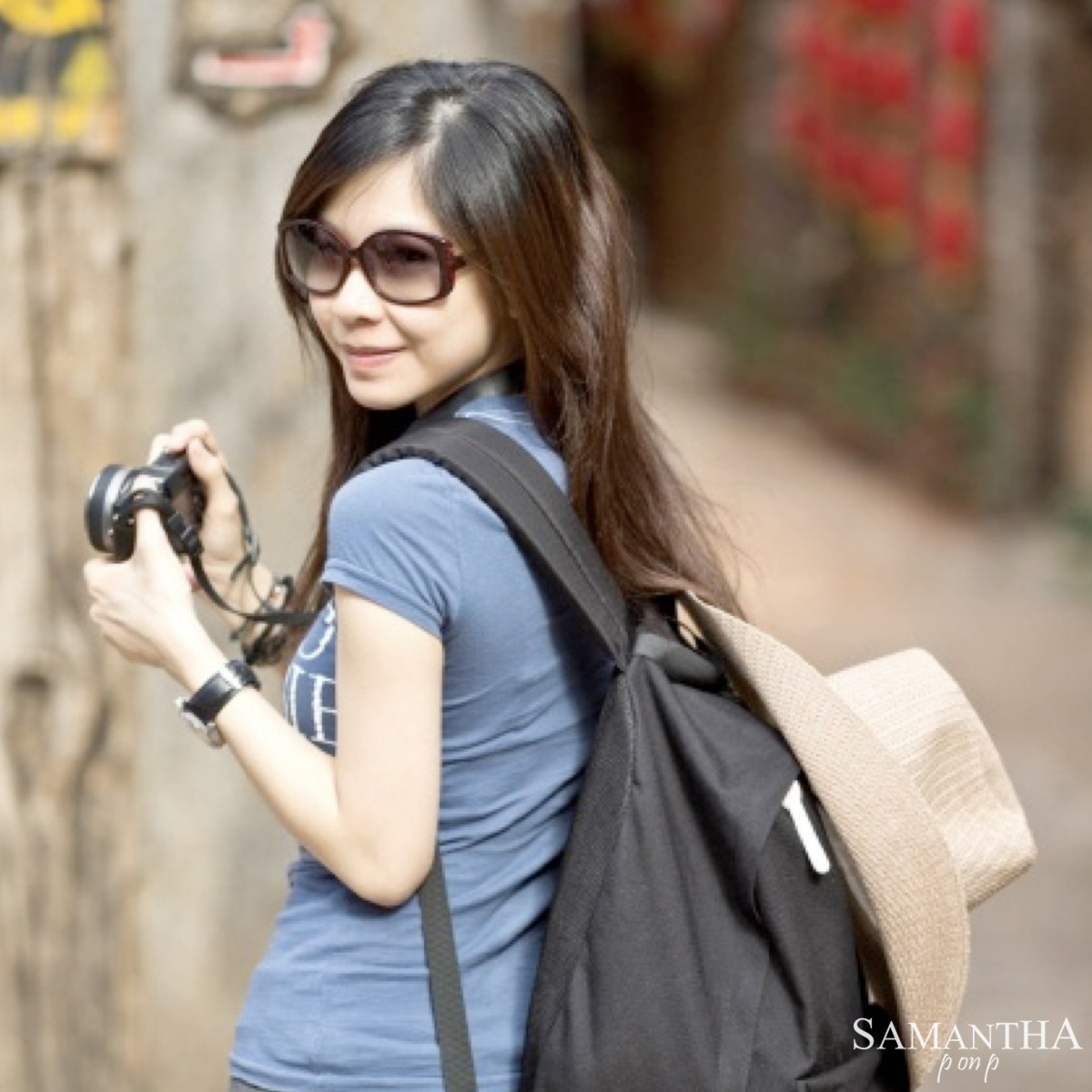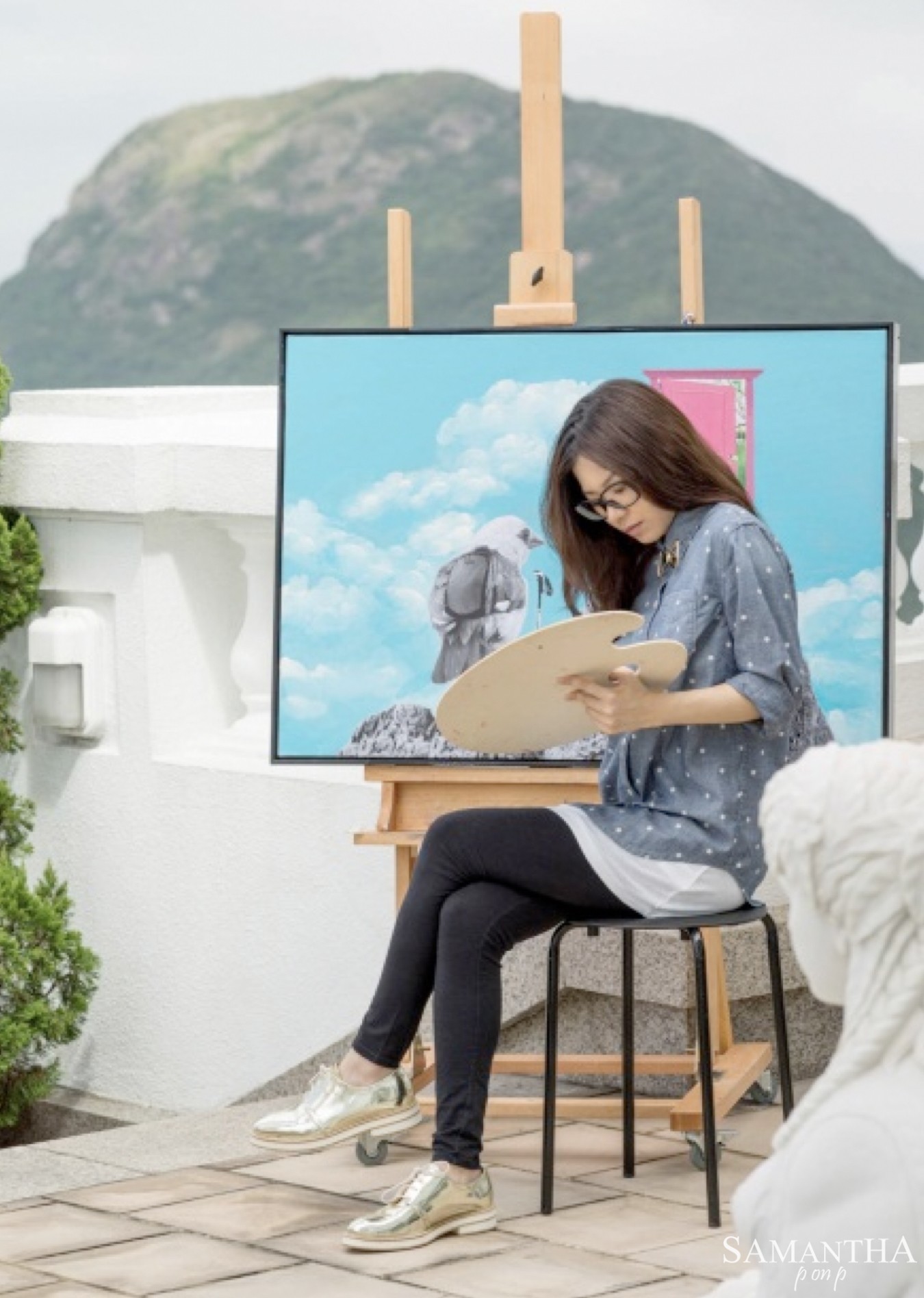ABOUT SAMANTHA
Personal Statement

「P on P」藝術創作者李楚洳(Samantha Li),是香港典型土生土長的新一代,畢業於香港大學藝術系,亦是「賽馬會鯉魚門創意館」其中一位首批培養的年輕藝術工作者,對藝術創作擁有無比熱誠。
Samantha自少熱愛文學及藝術,尤其醉心於攝影和繪畫。亦經常到內地不同的省市旅行遊歷,又曾到過多個國家旅行。這些遊歷大大擴闊了她的視野,面對多彩多姿和風俗各異的奇妙世界,人類與動物之間的關係令她啟發良多,並把所見所聞用鏡頭或畫筆記錄下來。

Samantha和許多年輕人一樣,對周圍事物充滿好奇和想象,她想到了把自己最喜愛的攝影和油畫糅合起來,將鏡頭拍攝下來的「現實」影像,按自己內心的想像,利用電腦技術加以處理,再嘗試配上油畫的「抽象及寫實」等不同手法描繪,以表達自己的觀點及對事物的感覺,希望別人能從「相中有畫」和「畫中有相」的意境中,分享到作者的內心世界。一系列首創的「P on P」(Painting on Photo)的藝術作品,就此誕生。
Samantha的作品曾先後在香港大會堂、賽馬會鯉魚門創意館、海港城•美術館、香港文化中心及香港中央圖書館展覽館展出,2013年於巴黎羅浮宮舉辦個人展覽,引起廣泛關注。
Full profile

Samantha Li, the creator of “P on P” art form, graduated with a major in Fine Arts from the University of Hong Kong. With passionate love for art, she is also one of the first artists from the Hong Kong Jockey Club Lei Yue Mun Plus.
Since her early life, Samantha has shown great enthusiasm in literature and arts, especially painting and photography. Other than different provinces in the mainland China, she has also visited many countries around the world. The travelling experience is a real eye-opener for her – after viewing the colourful world with different cultures, she is inspired by the relationship between human and animals, and determined to capture the scenes with her cameras and brushes.

Just like many young people, Samantha sees the world with curiosity and imagination. She then comes up with an idea to combine photography and painting, the two artistic media that she has most affection in, into a new art form – painting with imagination on the real-life photos after digital processing – with a hope that people can share her thoughts through her artistic prospects. Thereupon, the original “P on P” (Painting on Photo) series of artworks is created.
The “P on P” artworks were successively exhibited in the City Hall, Jockey Club Lei Yue Mun Plus, Gallery by the Harbour, Hong Kong Cultural Centre, and Hong Kong Central Library Exhibition Gallery, and Louvre Museum at Paris, receiving widespread concern.
「P ON P」創意靈感 / The creation of P on P
人類社會的文明擁有6000年歷史,文字記載了這些發展。但在更遠古的時候,當系統文字尚未形成之前的史前時期,人類往往採用圖形、畫像來幫助自己記憶、表達意思和互相溝通。這也是「象形文字」發展的基礎,中國文字與圖畫二者「相融」、「配合」、「演變」,關係微妙。
已知最古老的繪畫位於法國肖維岩洞(Grotte Chauvet),部分歷史學家認為它可以追溯至32000年前。有些考古學家對這些繪畫的存在有不少假設:假設一是那些繪畫是當時的人認為繪畫可以捕捉動物的靈魂,令他們狩獵更為順利;二是泛靈論的一種現象,表達他們對自然的尊敬;三是人類與生俱來已有自我表達的需要,而那些繪畫正是其結果;四是資訊傳播。
但無論是那一種假設,無可否認,都是文明的進展,繪畫都是展現人內心思想、記錄事物依據的途徑。
而另一種可以用以傳達感情、記載事物的視覺藝術就是攝影。1892年,世上第一張相片產生。十九世紀攝影的發明,對繪畫藝術是一個嚴重的挑戰,促使藝術家去尋找新的出路。第一張照片產生於十九世紀二十年代,到六十年代,照相術已經有了很大發展。
在此前,繪畫承擔著記載圖像的重要任務,隨著攝影術的普及,繪畫藝術已失去了它從前的絕對優勢。這種危機感促使一部分藝術家放棄了照片記錄式的傳統畫法,轉而尋找繪畫創意色彩和空間方面的新途徑。
在藝術世界,每個國家都各有其歷史,各有不同程度的發展。但總體上,我們可以發現越是富裕、強大的地域和朝代,藝術的水平就越鼎盛。當西方國家向東方擴張,東方的藝術和文化開始顯露於西方人眼前。而西方油畫在中國清代也頗受帝皇喜愛,如宮廷畫師郎世寧的清宮西洋風就是很好的例子。而油畫對其後中國繪畫的影響亦很深遠,近代有林風眠、吳冠中、徐悲鴻、趙無極、朱德群等著名畫家,現代更有張曉剛、岳敏君、劉野等人。
當時,西方畫家接觸到日本版畫、中國絲織品等東方藝術,其獨特的透視角度和單純的色彩構在他們面前展現了一個新的藝術世界,對他們擺脫傳統開始新的追求,也是一種促進和啟迪。印象派便在這種歷史條件下產生了。印象派是現代繪畫的起點,一批不甘受傳統藝術束縛、旨在革新的年輕藝術家,把審美價值定格在獨特的藝術形式之中,在這方面大膽探索,為現代藝術產生奠定了基礎。
後印象派則將這種形式主義藝術發揮到極致。畫家把形式作為第一著重點,幾乎不甚關注題材和內容。在藝術表現上,後印象派認為藝術形象要和生活中所見之物有所差異,希望能表現出「主觀化了的客觀」。後印象派的繪畫對現代諸流派的發展有著重大的影響。其代表畫家梵高更是表現主義的先驅,並深深影響了二十世紀藝術。畢加索是20世紀現代藝術的主要代表人物之一,他的作品大大結合了抽象的元素,帶給人更新、更深刻的感受。
20世紀末以來,伴隨著電腦在各個領域的迅速普及,數碼時代已經來臨,給人們的工作和生活帶來了新的方便及衝擊,應運而生的數碼相機,迅速進入了民用市場。隨著數碼技術和互聯網應用的進步,攝影更深入的融入人類的生活。數碼音樂播放機,流動電話等數碼化產品開始配備攝影功能,拍攝的圖片可以用短信、郵件等方式無線傳播,攝影開始多元化發展。可以說,數碼攝影是攝影技術領域中的一次十分引人注目的革命,為各類攝影開創了發展的新機遇。
隨著數碼攝影的普及,攝影可分為「前期攝製影像」及「後期電腦處理及打印」兩個部份。電腦功能的千變萬化,可以令圖片的處理更加「隨心所欲」,讓越來越多精彩且富有創意的圖片進入人們的視野。創意可以與攝影輕易地在圖片處理過程中「擦出火花」,創造出更多讓人驚歎的作品。
近百年來藝術流派紛繁,相繼更替。但很多「名家」、「大師」們認為繪畫就是一筆一筆畫上去的過程,而攝影就是原汁原味的,只靠光圈、快門決定了影象的效果。但時代是進步的,爲什麽我們不可以嘗試把它們相互結合,利用各個工具的優勢,創造出想要表達的效果。隨著藝術觀念的不斷擴大,出現了更多不同材料、不同藝術之間交流、碰撞、融合,從而產生了不歸屬於某一具體形式的綜合性藝術。
而「P ON P」(Painting on Photo)藝術的誕生,正正是順應了這一藝術潮流。
本人自幼就醉心於藝術,特別是繪畫和攝影,曾走遍中國、歐洲、日本、非洲、東南亞等地,拜訪名家,領略各地歷史、人文內蘊,盡享大自然風光,更將所看到的美麗用相機和畫筆記錄下來。
在繪畫方面,我偏愛以油畫顏料及丙烯顏料作畫。油畫約15世紀起源於歐洲,因為油畫顏料乾後不變色,多種顏色調和不會變得骯髒,畫家可以畫出豐富、逼真的色彩。油畫顏料不透明,覆蓋力強,所以繪畫時可以由深到淺,逐層覆蓋,使繪畫產生立體感。而丙烯顏料則會很快變乾,其後迅速失去可溶性,不再溶於水,且不易褪色,持久性較好。而丙烯顏料的覆蓋度低、較透明,所以若能在「P ON P」作品的創作中使用,則能透過顏料依稀看到印在畫布上的圖像。
攝影方面,近年來照相器材日新月異。「測光」、「對焦」、「連拍」等晶片科技為攝影提供了很大的幫助。感光速度調校更可解決一些光線不足環境下的拍攝。攝影者可以花更多時間在取景、構圖等方面。專業相機則可提供更高的像素及效果,拍出的「Raw」圖讓後期處理更方便。
而Photoshop,作為照片後期處理的重要工具之一,真的很「神奇」。無論是最基本的調色、光暗修改乃至後期複雜的製作等都可得心應手,由淺入深。我建議愛好攝影的朋友都學習使用。
我認為無論是繪畫或攝影,都是屬於留住美麗一刻的藝術手法,只是詮釋和演繹的方式不同,各擅勝場。因此,我嘗試著將這兩種自己深愛的藝術形式結合在一起,以寫實的相片作背景,利用電腦技術打印在畫布上,然後再繪上油畫,以這種「三合一」的手法,創作出系列「P ON P」的作品。
經過與不同人的交往,我發現,面對同一件照相機拍下來的實物,大家眼前的景象都是一樣的,但每個人內心理解和認知都可能有所不同。通過「P ON P」,我希望能表達自己內心的創意和思想,賦予照片全新的風貌,並讓觀賞者能夠從我的角度欣賞一件作品。希望這種藝術創作思維令人感到耳目一新,別有一番風味。
Human civilization has a history of 6000 years, most of which were recorded by written language. But at the primary stage of civilization when people had no letters, they were inclined to use images or pictures for memory, expression and communication. The pictograph is also an embodiment of the combined result of both characters and pictures.
The oldest known paintings are at the Grotte Chauvet in France, claimed by some historians to be about 32,000 years old. For pre-historical paintings, archaeologists have different assumptions: some assume that ancient people painted for the sake of easier hunting because they thought painting was a way to capture animals’ souls; some suppose this is a manifestation of animism, showing the respect for nature; some think that the paintings indicated the natural need for human beings to express their feelings; some consider the paintings to be a measure of communicating with others.
No matter which of these hypotheses might be true, undoubtedly, painting is definitely a reflection of a person’s inner side.
Another type of visual arts that carries the function of emotion expressing and memory recording is photography. In 1892, the first photo ever in the world was invented. Its invention in the 19th century is threatening the role of painting, urging painters to search for innovative ideas and forms of creating artworks. Till the 1860s, its technology has developed into a relatively mature phase.
Before the invention, painting was regarded as a tool to record images of daily life. However, it lost its superiority to photography in the domain. With crisis awareness, painters had to give up the traditional photo-like techniques of drawing and explore a brand new way in painting, including the variation of colours, forms, techniques and creativity.
When the eastern style of art and culture were exposed to the western artists, such as Japanese engravings and Chinese silk artworks, they inspired the painters with unique angles, scenography and simple colours. This novel artistic world gave stimulus to the artists. Getting rid of the old-fashioned mode and pursuing a fresh start, they became the first artists of Impressionism – the beginning of modern painting. Impressionist painters, who are not restraint by tradition and aimed at innovation, realised the unique value of artistic form and explored this aspect with audaciousness, laying a foundation for modern arts.
Post-Impressionists extended formalism to its acme without even taking into account any subjects or contents. Regarding to the performance, the painters believe that subjective emotions transform objective images in arts (“subjectified object”), because they think artistic images should be different from the original. Post-Impressionism has greatly influenced the development of most styles of modern arts. Vincent van Gogh was a representative who showed honest emotions in his works, and had a far-reaching impact on 20th-century art. Pablo Picasso was one of the greatest and most influential artists of the 20th century, whose works, combining lots of abstract elements, have brought refreshing and impressive feelings.
The end of last century witnessed computer’s popularisation and the coming of digital age, bringing our life new impacts. Digital cameras were introduced at the historic moment and rapidly won people’s heart. As digital technology and Internet develop, using MP3, mobile phones and other products with camera, photo taking is becoming more and more essential. Assorted equipment and modes of transmission have also diversified photography. Innovations are brought to all kinds of photos by digital camera, whose invention, technically, is a conspicuous revolution in photography.
With a digital camera and a computer, we now can do whatever we want with the photos. Much more wonderful pictures with creativity are, therefore, entering people’s sights. Imagination is the core value of digital processing, creating increasing amount of amazing works.
In the recent hundreds of years, art genres tend to become more and more numerous and complicated. The crash and crossover among assorted art styles, as the artistic concepts expand, are forming a kind of integral art that cannot be categorised into one particular form.
The creation of “P ON P” (Painting on Photo) is exactly on the new trend.
Since young, I had a special love for art, especially for painting and photography. I was fortunate enough to have visited many places in the world, including China, Europe, Japan, Africa, Southeast Asia, etc. The historical sights, humanity and natural views were not only remembered in my heart, but also recorded by cameras and painting brushes.
I prefer doing oils and acrylics when I paint. Painting originated in the 15th century. Oil paint doesn’t discolour after dry, so artists can use abundant and living colours for the paint won’t get dirty when mixed. Its high opacity helps with the sense of hierarchy and layering. On the other hand, acrylic paint is fast drying paint that can be diluted with water, but become water-resistant and lasting when dry. It’s relatively transparent. So if used in “P ON P”, it allows us to vaguely see the original photo underneath the paint.
Painting, as well as photo taking, in my opinion, is a means of artistic expression for retaining the moment of beauty. They differ only in their ways of interpretation and presentation. Therefore, I try to combine the two styles of art that I love most together – based on backgrounds of realistic photos, using computer technology to print the photos onto canvas, I then paint on it with imagination. The 3-in-1 technique is the originality of “P ON P”.
I have discovered, in the course of social intercourse, people hold various opinions towards the same object – even though they are looking at the same photo, what they feel and get might differ enormously. My expectation is to express the creativity and thoughts deep in my heart through “P ON P” works, so that after the photos are decorated with my ideas, viewers are able to see things from my point of view. I wish the artistic ideas are refreshing for the general public.
The picture album consists of a series of “P ON P” work pieces, and hopefully, it is an embodiment of the creating spirit of the young generation in Hong Kong. The book is filled with imaginary paintings of “how animals’ life develops like human beings”. I believe, after the works, which are combined of realistic and abstract factors, are shown to the public, this type of creation will bring you to a new angle and enable you enjoy the new art trend.
